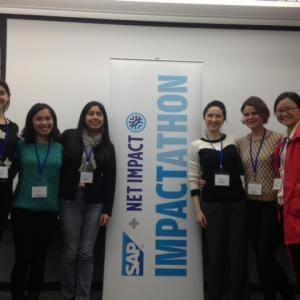Impactathon Creates a Better World and Better Careers

This is a guest post written by a Net Impact member, originally published on the Simmons Net Impact blog.
%20(1)-300x300-3.jpg) On October 11, 2014, SAP and Net Impact co-hosted a design thinking event, called an Impactathon, that I had the pleasure of attending. It was a prime example of the innovative ways social entrepreneurs can partner with large corporations to create good in the world – while building career skills!
On October 11, 2014, SAP and Net Impact co-hosted a design thinking event, called an Impactathon, that I had the pleasure of attending. It was a prime example of the innovative ways social entrepreneurs can partner with large corporations to create good in the world – while building career skills!
The purpose of the day-long event was to gather sustainably minded individuals from diverse backgrounds to tackle the critical topic of motivating young students to build the new skills that will be needed to power the economy of tomorrow – such as programming, graphic design, data analysis, and entrepreneurial thinking.
To illustrate the importance of this challenge, 60% of global CEOs report a gap in skilled labor. Specifically, the challenge was focused on low-income students; 65% of low-income youth are graduating from high school today, while 87% of higher-income students graduate.
SAP has already started to address this issue by “building a STEM talent pipeline with a new high school modeled on technology.” In hosting the event, they sought to expand upon this start by generating ideas incorporating mentoring, teacher training, policy advocacy, and more. When I told my fellow attendees that I work in education services at a large technology company and have a passion for collaborative learning for workforce development, multiple people commented: “You’re in the right place today.” At the start of the day, I was excited to get started and learn what sustainability principles I could support and bring back to my daily work.
I was not disappointed! Net Impact guided a group of about 40 undergraduate student, graduate student, and professionals through a human-centered design and prototyping process that got to the heart of the challenges facing today’s youth. Our work was centered around profiles of two struggling students – one being pulled away from school by peer pressure and a sense that his school curriculum was irrelevant to him; and the other whose family needed her to work full time for financial support. By interviewing these “students” in role plays about their hopes and barriers to achievement, we started the day with the empathy that underlies truly sustainable thinking.
We also got to know each other pretty quickly as Impactathon participants – my team included business students from multiple countries, lines of work, and age groups, each of whom brought a valuable perspective to the next phase of the day: defining a pain point of the profiled students, and prototyping a way business and schools can work together to address it. We used sticky notes and a sense of humor to think of many options. These included bringing successful alumni back to schools to speak and inspire students; hiring students to analyze and solve high schools’ operational challenges; and businesses offering scholarships to sponsor promising students who would otherwise have to work instead of doing homework.
At lunch we heard the Superintendant of a Boston school speak about the many programs he is using to pull students in and build them up as academic leaders – including the setbacks and opportunities faced by his students.
After lunch, we tried out the Marshmallow Challenge, to lighten up and enjoy a little bit of sugar.
Then it was back to work, for our final round of sustainable design! Each of the six teams in the Impactathon developed a prototype of a way for business and education to partner up to build a competitive workforce. It was kind of like the reality show The Apprentice, but for idealists. We received feedback from school and business veterans along the way, started over from scratch multiple times, and got to play with Play-Doh that was left at each team’s table (to remind us to stay flexible).
Finally, around 4pm, it was time for each team to present our work to a panel of judges. The solutions presented included a skill-sharing app (think Airbnb for students instead of travelers), a good number of variations of internship-broker programs, and the winning entry – a platform by which individuals can connect with and invest in promising students.
So my team didn’t have the winning idea, but I’m pretty sure that everybody who participated in the Impactathon won in some way. We gained a deeper understanding of a pressing issue facing a majority of businesses. We learned how to solve problems from a place of humanity rather than competition. And we came to see that a sustainable world is much more likely when business and society take the time to see where our problems overlap – and that we can learn to design our way forward.




